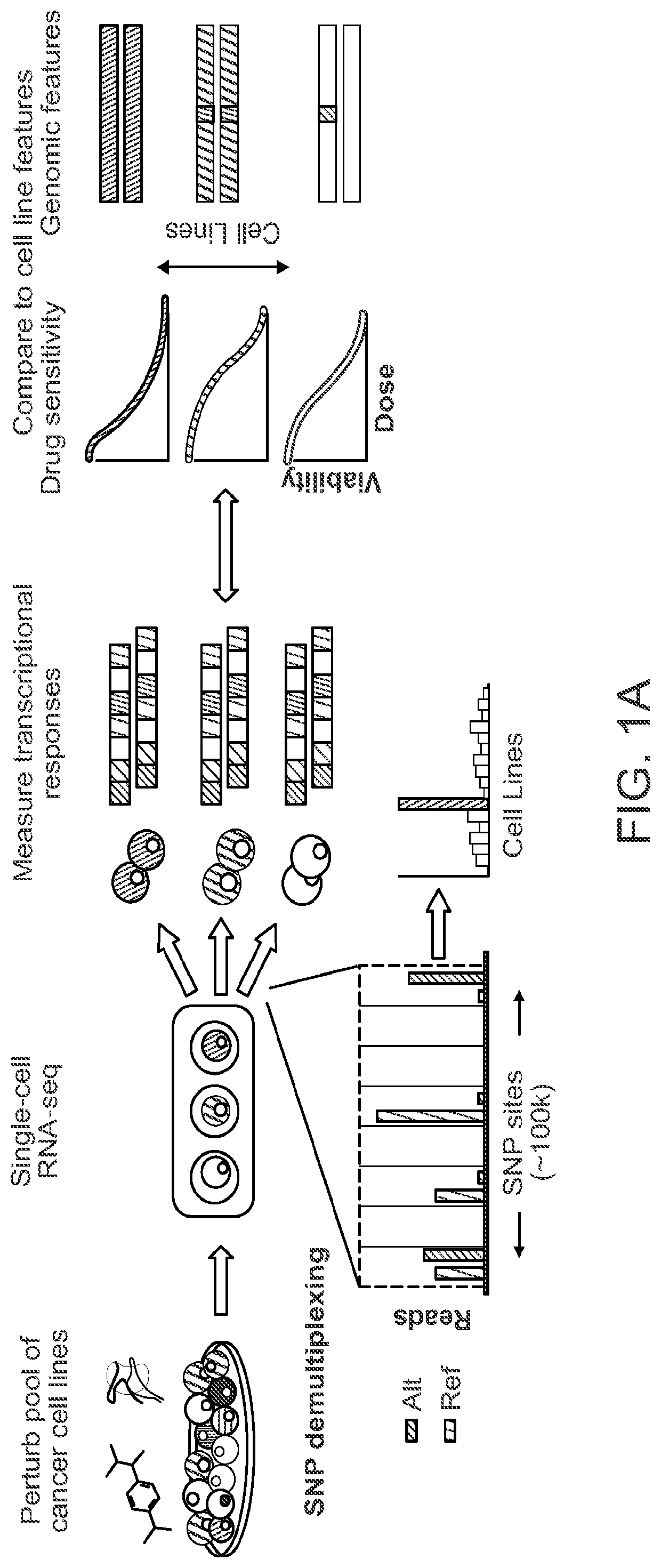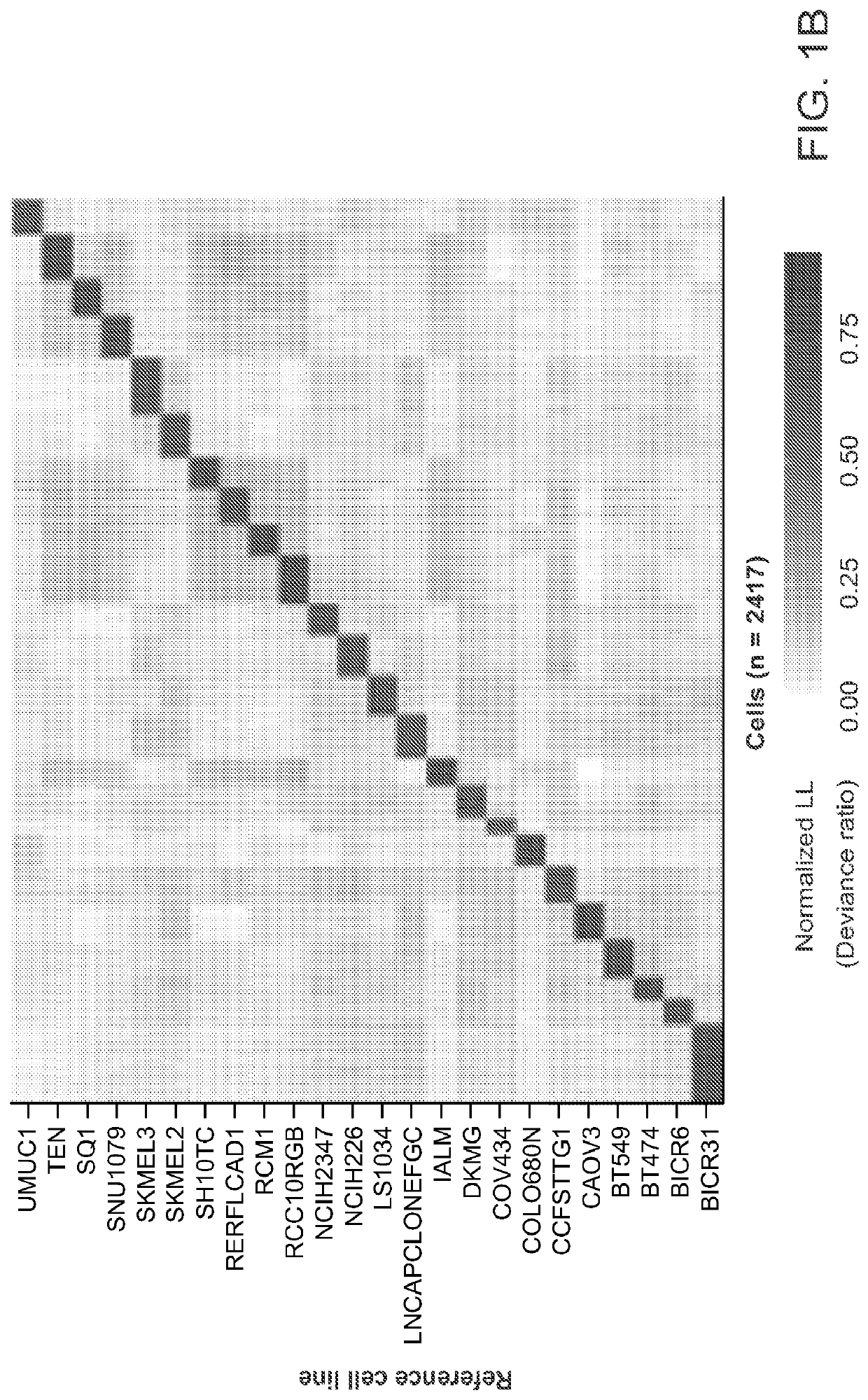Rapid prediction of drug responsiveness
a drug responsiveness and rapid prediction technology, applied in the field of rapid prediction of drug responsiveness, can solve the problems of cancer significant morbidity, no standard biomarker-driven strategy,
- Summary
- Abstract
- Description
- Claims
- Application Information
AI Technical Summary
Benefits of technology
Problems solved by technology
Method used
Image
Examples
example 1
and Methods
[0217]Cell line pools were made in sets of 25 cell lines. These 25 cell line pools were chosen based on doubling time and were grown in RPMI in the absence of phenol red and with 10% FBS. Cell lines were then washed with 10 mLs of PBS, and trypsinized with 1 mL trypsin which was then removed. Ten mLs of RPMI media were added to the cells post trypsinization and resuspended. Cells were then counted by a Nexcelom cellometer using 10 uL of cell suspension and 10 ul of Trypan blue. Equal numbers of cells per cell line were mixed together and spun down at 1,250 RPM for 5 minutes. Media was aspirated and the cells were resuspended in Sigma Cell Freezing media and frozen in 1 mL aliquots. This process was repeated for all of the 25 cell line pools. For MIX-Seq experiments involving larger pools, multiple 25 cell line pools were thawed in RPMI with 10% FBS, spun down and resuspended in 5 mLs of RPMI media. Cells were then counted and equal numbers were combined t...
example 2
ed Cell Line Transcriptional Profiling Using scRNA-Seq
[0264]Development of the MIX-seq platform is disclosed herein. MIX-seq uses single-cell RNA sequencing (scRNA-seq) to measure the transcriptional effects of a perturbation across diverse cancer cell lines cultured and perturbed in one or more pools (see FIG. 1A). These pools were then treated with a small molecule compound (or genetic perturbation) (Yu et al. 2016). To ascertain transcriptional response signatures, cell-specific transcriptomes were measured using scRNA-seq after a defined time interval following perturbation. To assign each profiled cell to its respective cell line, an optimized computational demultiplexing method was developed that classified cells by their genetic fingerprints, similar to recently developed methods, such as the Demuxlet method.
[0265]Specifically, for each single cell, the reference cell line whose genotype across a panel of commonly occurring SNPs would most likely explain the observed pattern ...
example 3
dentified Selective Perturbation Responses and MOA
[0267]The ability of MIX-seq to distinguish biologically meaningful changes in gene expression in the context of drug treatment was evaluated. Pools of well-characterized cancer cell lines were treated with thirteen drugs, followed by subjecting the cells to scRNA-seq at 6 and / or 24 hours after treatment. These drugs included eight targeted cancer therapies with known mechanisms, four compounds that broadly kill most cell lines, and one tool compound (BRD-3379) with unknown mechanism of action (MoA) that was found to induce strong selective killing in a high-throughput screen. In all cases scRNA-seq based phenotyping was compared to long-term viability responses measured for these drugs and cell lines from the genomics of drug sensitivity in cancer (GDSC) dataset (Iorio et al. 2016 and Garnett et al. 2012), as well as data generated using the PRISM assay (Corsello et al. 2020 and Yu et al. 2016, see Example 1 above).
[0268]As a benchm...
PUM
| Property | Measurement | Unit |
|---|---|---|
| time | aaaaa | aaaaa |
| time | aaaaa | aaaaa |
| time | aaaaa | aaaaa |
Abstract
Description
Claims
Application Information
 Login to View More
Login to View More - R&D
- Intellectual Property
- Life Sciences
- Materials
- Tech Scout
- Unparalleled Data Quality
- Higher Quality Content
- 60% Fewer Hallucinations
Browse by: Latest US Patents, China's latest patents, Technical Efficacy Thesaurus, Application Domain, Technology Topic, Popular Technical Reports.
© 2025 PatSnap. All rights reserved.Legal|Privacy policy|Modern Slavery Act Transparency Statement|Sitemap|About US| Contact US: help@patsnap.com



